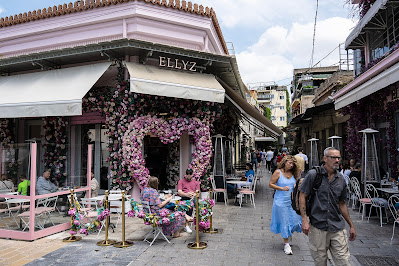Before we left for Greece in April, I dutifully purchased Anthony Everitt’s, “The Rise of Athens,” and carried it with me into the Grand Canyon and on the San Juan River. Despite reviews touting its readability, I never made it past the first few chapters. Greek history isn’t as compelling when you’re deep in the U.S. desert southwest looking at petroglyphs. But even more daunting for me, the list of “characters,” mythical and historic, mentioned in the introduction alone included: Alexander the Great, Phillip, Achilles, Agamemnon, Hector, Odysseus, Homer, Chryseis, Apollo, Zeus, Hera, Athena, Paris, Aphrodite, Helen, King Menelaus, Briseis, Thetis, Aias, and many more, all interacting in complicated and magical ways while wandering through Athens, Sparta, Macedon, Phrygia, Troy, and Persia (another partial list), all places unfamiliar to me. And don’t even ask about the Ionic vs. Corinthian vs. Doric columns.
So, with apologies to Greek historians, after two weeks of happy mindless climbing on Kalymnos, I stepped off the twin-engine Aegean Air prop plane in Athens with little knowledge of the city’s thousands of years of history, intent, along with the tourist throng, on visiting the Acropolis and the Peloponnese Peninsula, while secretly looking forward to a meal or two that was neither Greek nor Mediterranean.
We stayed in a nice retro-themed apartment in the Kerameikos District of Athens (Kerameikos is the root of our word "ceramics") within walking distance of the Acropolis and set out the day after we arrived. The centerpiece is the Parthenon, the famous temple dedicated to Athena. It dominates the polished limestone fortress atop the famous hill even as modern Athens laps at it from all sides, a sea of white buildings fading into the distant smog. Despite the crowds, it’s breathtaking.
Immediately surrounding the Acropolis are narrow streets lined with cafes, some serving cheeseburgers and fries.
Although one could spend weeks exploring Athens, we knew better, having long ago probed our tolerance (low) for big cities, so we rented a car and drove two hours to Nafplio, a much smaller tourist town beside the Mediterranean, where the Peloponnese Peninsula meets the Greek mainland. Pre-trip research touted Nafplio as a convenient base for visits to ancient Corinth, the theater at Epidaurus, and the ruins of Mycenae, and it wasn’t lost on us that it is only two hours from Leonidio, another huge Greek sport climbing destination. An old castle looking down on Nafplio can be accessed from town by climbing 999 steps (I didn’t count), and Nafplio's narrow streets are packed with upscale shops, restaurants, and gelato stands. We spent four days in the area before returning to Athens to catch our flight back to Denver.
It's easy to understand why expats retire in Greece and climbers spend months there. The weather is mild, it’s relatively inexpensive, the food is good, and the people are genuinely friendly. Of course that’s a superficial view; Greece has seen more than its share of political and economic upheaval. But I can’t say that I was in a hurry to fly home after our short visit.
The pictures below are from our tourist week on the Greek mainland after Kalymnos, and I’ve included a little logistical info at the end.
Logistics
Athens Airport to Athens: The airport is far outside of downtown Athens, but it's easy to take the metro. Follow the signs and purchase a "30-minute" ticket at the kiosk (9 euros, takes credit cards). A 40-minute ride took us to within walking distance of our apartment.
Athens: We stayed in the Kerameikos District which has lots of restaurants and places to stay and is within walking distance of the metro and the Acropolis. There are other popular districts close to the Acropolis. The Plaka area NE of the Acropolis is apparently nice but we didn't stay there. Our apartment was called Karamos Athens and was very comfortable. There are many lodging options.
Car Rental: We returned to the airport (metro) to rent a car and then drove to Nafplio via Corinth. The driving is easy on freeways the whole way (you don't have to drive through downtown Athens). Freeway tolls can be paid with a credit card or cash. Our rental car company (AutoUnion) turned out not to be at the airport proper (they shuttled us to their office). It would have been more convenient to have picked a rental car company that was actually at the airport, so pay attention to that if it matters to you.
Nafplio: Nafplio is touristy but enjoyable for a short visit. There are hundreds of places to stay there. We booked the Kallisti Pension which was very nice, centrally located, and served a huge breakfast every day (included).
Leonidio: From Nafplio it was about a 2-hour drive to Leonidio, a smaller town on the coast to the southwest. Leonidio is another major Greek climbing destination (see Mountain Project or climbinleonidio.com) but we only spent a day there. There are 1,500+ routes on high quality limestone with steep tufa caves (e.g., Sector Mars). It's primarily a winter area since most cliffs face south but there are shady sectors.
























Thanks Ken! With my low tolerance for airports and big cities, I'm continuing to enjoy the armchair travels.
ReplyDeleteHa. Except when you are hiking hundreds of miles!
Delete